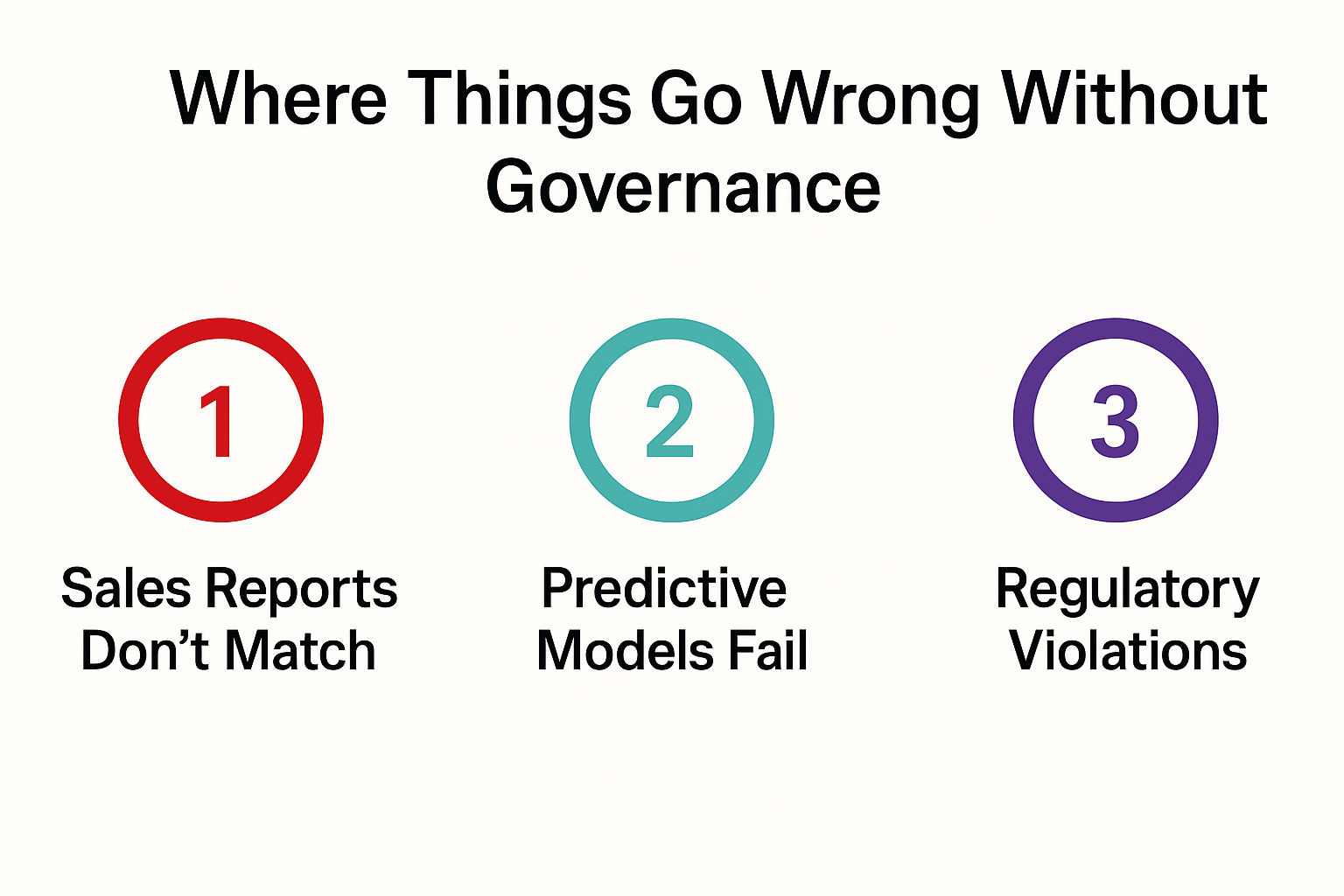Most organizations today rely on dashboards to track business performance. But here’s the truth: many of those dashboards are lying.
They’re built on outdated, inconsistent, or incomplete data. They show what looks like insight, but often it’s noise. And that’s a big problem because when decisions are made based on that noise, companies lose money, miss opportunities, or make costly missteps.
Enter artificial intelligence (AI). AI is revolutionizing how we work with data. It can automate insights, forecast trends, and spot problems before they happen. But it can’t fix bad data. In fact, it often makes the problem worse by amplifying the errors.
That’s why AI-driven data visualizations only work when your data is governed. At FreshBI, we believe the future of business intelligence depends on pairing AI power with data discipline. Let’s explore why.
What Is Data Governance and Why Should You Care?
Data governance refers to the management framework that defines how data is collected, stored, accessed, and used across an organization. Think of it like plumbing: data governance ensures that the data flowing through your systems is clean, well-structured, and secure.
Good governance:
- Eliminates duplicate and conflicting data
- Ensures everyone uses the same definitions (what exactly is a ‘qualified lead’?)
- Prevents sensitive data from being mishandled
- Tracks where data came from and how it’s changed

Poor governance? It creates chaos. Teams pull numbers from different sources, reports contradict each other, and trust in dashboards disappears.
At FreshBI, we start every engagement with a data governance audit. If your dashboards aren’t grounded in governed data, we don’t just apply AI – we help you fix the foundation first.
How AI Visualizations Really Work
AI driven visualizations use algorithms to interpret large volumes of data and highlight what matters. These visualizations:
- Detect patterns humans might miss
- Predict outcomes based on historical data
- Automatically update in real time
- Flag anomalies or risks
Imagine a sales dashboard that doesn’t just show last month’s numbers but forecasts this month’s revenue, highlights underperforming regions, and recommends actions. That’s the power of AI—but only if the data is consistent and accurate.
FreshBI builds these kinds of solutions using advanced AI and machine learning models, but we never do it without governance. Without clean data, even the best algorithm is useless.
Where Things Go Wrong Without Governance
Let’s look at a few real-life issues caused by poor data governance:
1. Sales Reports Don’t Match – One team pulls numbers from the CRM, another from a spreadsheet. There’s no agreement on which is right. Strategy stalls.
2. Predictive Models Fail – A retail company’s AI recommends inventory levels based on corrupted seasonal data. They overstock, burn cash, and have to discount excess inventory.
3. Regulatory Violations – Financial institutions report on customer metrics, but without access controls, sensitive data is leaked. Fines follow.
These aren’t just minor inconveniences. They’re signs of serious structural weaknesses. Fixing them starts with solid data platform architecture and a clear governance plan.
What Great Governance Looks Like in Practice
At FreshBI, we’ve developed a governance-first framework that ensures our AI dashboards work reliably and securely:
- Source Validation – We trace every data point back to its origin to eliminate duplicates or inconsistencies.
- Defined Ownership – Each dataset has a clear owner responsible for its quality.
- Metadata Mapping – Every column and label is defined so teams can interpret the data the same way.
- Access Control – Sensitive information is restricted and encrypted, with audit logs for compliance.
- Regular Reviews – Data pipelines are checked regularly to catch and fix issues early.
By weaving governance into our process, our business intelligence consulting delivers long-term value—not just short-term dashboards.
Client Story: Turning Messy Data into Growth
A global equipment rental company was struggling to understand why certain regions underperformed. Reports contradicted each other, and executive trust was low.
FreshBI stepped in with a two-phase approach:
Phase 1: Governance Overhaul – We mapped all data sources, removed redundancies, and created a unified data lake.
Phase 2: AI-Powered Dashboards – Using clean data, we built dashboards that showed:
- Which regions had seasonal variance
- How pricing impacted rental duration
- Which salespeople drove the most repeat business
The outcome: Revenue grew 17% in the next quarter and dashboard trust reached 100%.
More Use Cases for AI + Governance
Here are more places where governed data and AI-driven dashboards drive real value:

- Healthcare – Track patient satisfaction while maintaining HIPAA compliance.
- Retail – Predict returns and optimize merchandising by geography.
- Construction – Monitor project risks in real time using AI alerts fed by governed budget and progress data.
- E-commerce – Optimize pricing engines with machine learning models trained on consistent purchase and returns data.
Each of these depends on trusted data. That’s what we deliver.
Final Thoughts: Governed Data Is Non-Negotiable
Businesses don’t need more data, they need better data. AI is an incredible tool, but it only works when the foundation is sound.
At FreshBI, we’ve helped clients across industries unlock the real power of AI and visualization by starting with governance. If you’re serious about using data to grow your business, this isn’t optional. It’s urgent.
We’re ready when you are.
Next Step: Let’s Talk About Your Data Goals
Schedule your free consultation today. Let’s build smarter dashboards powered by AI, guided by governance, and aligned to what matters most in your business!







